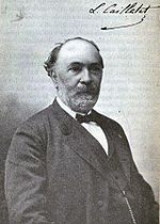
Louis Paul Cailletet
Encyclopedia
Louis-Paul Cailletet was a French physicist
and inventor.
, Côte-d'Or
. Educated in Paris, Cailletet returned to Châtillon to manage his father's ironworks. In an effort to determine the cause of accidents that occurred while tempering incompletely forged iron, Cailletet found that heating the iron put it in a highly unstable state, with gases dissolved in it. He then analyzed the gases from blast furnaces, which helped him understand the role of heat in the changes of states (phases) of metals. This brought him to the work of liquefying the various gases.
Cailletet succeeded in producing droplets of liquid oxygen
in 1877 but by a different method from that used by Raoul Pictet
. He used the Joule-Thomson effect
. The oxygen was compressed while being cooled. The compressed gas was then allowed to expand rapidly, cooling it even more. The result was the production of small droplets of liquid oxygen.
Among his other achievements, Cailletet installed a 300-m/985-ft high manometer on the Eiffel Tower; conducted an investigation of air resistance on falling bodies; made a study of a liquid-oxygen breathing apparatus for high-altitude ascents; and developed numerous devices, including automatic cameras, an altimeter, and air-sample collectors for sounding-balloon studies of the upper atmosphere.
Physicist
A physicist is a scientist who studies or practices physics. Physicists study a wide range of physical phenomena in many branches of physics spanning all length scales: from sub-atomic particles of which all ordinary matter is made to the behavior of the material Universe as a whole...
and inventor.
Life and work
Cailletet was born in Châtillon-sur-SeineChâtillon-sur-Seine
Châtillon-sur-Seine is a commune of the Côte-d'Or department in eastern France.-Population:-Personalities:Châtillon-sur-Seine was the birthplace of:* Auguste Marmont, duke of Ragusa , Marshal of France...
, Côte-d'Or
Côte-d'Or
Côte-d'Or is a department in the eastern part of France.- History :Côte-d'Or is one of the original 83 departments created during the French Revolution on 4 March 1790. It was formed from part of the former province of Burgundy.- Geography :...
. Educated in Paris, Cailletet returned to Châtillon to manage his father's ironworks. In an effort to determine the cause of accidents that occurred while tempering incompletely forged iron, Cailletet found that heating the iron put it in a highly unstable state, with gases dissolved in it. He then analyzed the gases from blast furnaces, which helped him understand the role of heat in the changes of states (phases) of metals. This brought him to the work of liquefying the various gases.
Cailletet succeeded in producing droplets of liquid oxygen
Liquid oxygen
Liquid oxygen — abbreviated LOx, LOX or Lox in the aerospace, submarine and gas industries — is one of the physical forms of elemental oxygen.-Physical properties:...
in 1877 but by a different method from that used by Raoul Pictet
Raoul Pictet
Raoul-Pierre Pictet was a Swiss physicist and the first person to liquefy nitrogen. He was born in Geneva and served as professor in the university of that city...
. He used the Joule-Thomson effect
Joule-Thomson effect
In thermodynamics, the Joule–Thomson effect or Joule–Kelvin effect or Kelvin–Joule effect describes the temperature change of a gas or liquid when it is forced through a valve or porous plug while kept insulated so that no heat is exchanged with the environment. This procedure is called a...
. The oxygen was compressed while being cooled. The compressed gas was then allowed to expand rapidly, cooling it even more. The result was the production of small droplets of liquid oxygen.
Among his other achievements, Cailletet installed a 300-m/985-ft high manometer on the Eiffel Tower; conducted an investigation of air resistance on falling bodies; made a study of a liquid-oxygen breathing apparatus for high-altitude ascents; and developed numerous devices, including automatic cameras, an altimeter, and air-sample collectors for sounding-balloon studies of the upper atmosphere.

